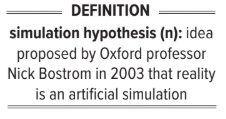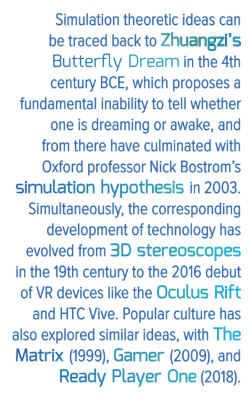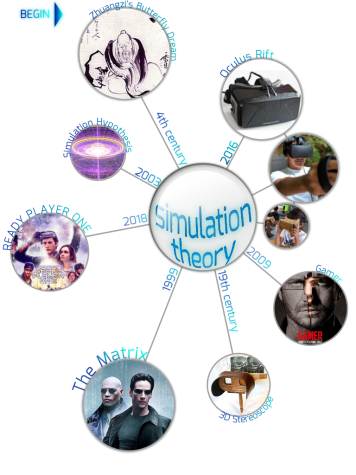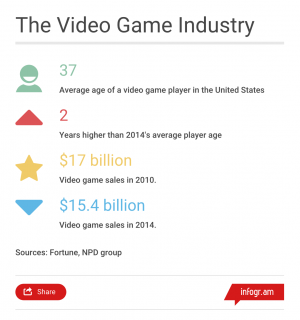Exploring Virtual Worlds and Simulations
December 10, 2018
Science fiction has long theorized about the existence of lifelike simulations, with movies like The Matrix (1999), Gamer (2009) and, most recently, Ready Player One (2018). However, with the rise of virtual reality technology and the exponential growth of computers, many scientists and philosophers, including Elon Musk and the late Stephen Hawking, have begun to ask: “Is this real?”
“I remember reading science fiction stories by Arthur C. Clarke in the 1960s [about] the idea of our equipment becoming potentially self aware and the highlight of the story is that we are actually pieces of equipment in someone else’s universe that’s becoming self aware,” Dr. Eric Nelson, physics teacher and chair of the upper school’s computer science department, said. “And people have been asking, just like in the movie The Matrix, are we living in a giant simulation, and if we were, how would you know? How could you tell?”
Simulation theorists propose that our universe is highly likely to be a simulation, created by a far more advanced civilization. Theorists argue that “posthuman” civilizations have sufficient computing power to run simulations — thus, as the vast majority of minds will be simulated, we are likely to be simulated as well.
“I think it’s totally possible,” Alexander Young (12), president of the Philosophy Club, said. “With regards to the physics, there’s lots of different physical anomalies in the laws of physics and chemistry that are unexplained, mostly likely because we don’t have a sufficient understanding of the world around us, but it’s also possible that these are chinks in the code, bugs in the world around us.”
On the other hand, many argue that a simulation would be much more apparent to its inhabitants, and creating such a system would require far too much effort.
“It would be clear that it is a simulation because there’s a limit to the capabilities of any computational system, and nature doesn’t seem to have these limits at this point in time,” Dr. Nelson said. “A simulation that was able to keep track of all the details would be as big as the universe. You’d have to have something bigger than the universe to simulate the universe.”
While simulation theory evokes deep philosophical arguments on both sides, computer scientists propose a major obstacle stands in the way of its possibility on the concrete side: the sheer magnitude of computational power that would be required.
 “Let’s say you got a box with a 100 electrons in it and you want to model it as precisely as we are able to observe it over extended periods of time. You would need a computer with more parts than there are atoms in our known universe,” Dr. Nelson said. “That’s a big computer, and that’s only a 100 electrons. Now try modeling the universe.”
“Let’s say you got a box with a 100 electrons in it and you want to model it as precisely as we are able to observe it over extended periods of time. You would need a computer with more parts than there are atoms in our known universe,” Dr. Nelson said. “That’s a big computer, and that’s only a 100 electrons. Now try modeling the universe.”
Simulation theorists respond by arguing that the code for the simulation may operate on a higher plane of understanding, beyond the scope of what humans can foresee or achieve at this time. Yet the idea of simulations is already becoming more and more familiar in the current technological sphere with the growth of the virtual reality (VR) sector. In concept, virtual reality seems like a direct route to launching a full-fledged simulation perhaps as detailed as a world, or even a universe, but the key question is how VR technology concretely compare to the proposed systems necessary for a full simulation.
The development of current VR technologies is far more tractable and defined than the philosophical quandaries of simulation theory. With the development of headsets like the Oculus Rift and HTC Vive over the last few years, VR has made its grand entrance into the consumer market but still has much untapped potential of use in various fields.
”A lot of the VR development has been pushed through the gaming industry. I would say in the next five years at least, we [should] see a lot of VR coming into the aspects of the education sector, as in the way education is being delivered to the students,…and information visualization in general, [for example] particularly in the domains of medicine analytics, ” Bala Thoravi Kumaravel, a second-year Ph.D. student at the University of California at Berkeley researching VR and augmented reality (AR) technologies, said.
Diane Main, the upper school’s Director of Learning, Innovation, and Design, noted that simulation technology can certainly expand the borders of education but often comes with accessibility issues that limit the demographic of consumers.
” As technology improves, we will certainly see [VR] incorporated more into classrooms and other educational settings,” Main said. “However, I am always concerned about the ‘digital divide’ that exists between people with means and privilege and those whose homes and schools may not be equipped with the technology that allows them to stay innovative and engaging… With VR, [we need to] always be on the lookout for ways to maintain equity of access for all learners.”
Despite the popularity and anticipated applicability of VR in various markets, VR currently faces a similar roadblock to the one that skeptics of simulation theory cite for evidence: the problem of the magnitude of computation. Transitioning from two-dimensional graphics to three-dimensional graphics requires significantly more power, explaining why heavy-weight computing systems are often required for VR headsets.
But unlike the computational argument against simulation theory, the power problem for VR and necessity for depth-based perception will be solved, as Nelson suggests, just once technology and computational abilities become “good enough” for the effect of VR.
“The solution, I suspect, will be having multi-processors boards, where each high-speed graphics processor is going to be dedicated to each plane, and we’ll find out how many planes you need to get the effects you’re looking for. In other words, when is good ‘good enough’ for the game?” Nelson said. “But I don’t know where that is yet, I don’t know if anything has figured that out.”
The prospect of using VR to create some degree of an immersive simulated world is not unreachable. Using a VR headset and haptic to fully act in a simulated reality, as depicted in Ready Player One, can certainly be feasible in the future.
“[Technology depicted] in Ready Player One is sort of possible. In fact, I might even go to say that we have the technologies and computing power to facilitate that now, but we don’t have a clear integration of [them],” Kumaravel said.
Several recent developments in the fields of artificial intelligence and virtual reality suggest significant progress toward a future where greater degrees of simulation are possible. One such advancement is Google Duplex, an intelligent voice assistant capable of having a natural conversation with a human. Duplex made headlines last May for apparently passing the Turing test, which is a benchmark for AI technologies to display behavior indistinguishable from humans but is perhaps just a small advance in a much longer journey.
“The Turing test is a big step. Baby steps are big steps if you’re a baby. For us, it’s a big step,” Nelson said. “A 100 years from now, it won’t be.”
When it comes to developing a simulation mimicking the universe we live in, there are countless obstacles and problems, those foreseen and unforeseen, to be solved along the way, if the goal is even feasible. But for now, every concrete development, from tackling the Turing test to overcoming technological challenges to expand the VR industry, is a noteworthy step to be recognized and remembered as humankind is launched into a future of science fiction.
A shorter version of this piece was originally published in the pages of The Winged Post on Dec. 6, 2018.


















![“[Building nerf blasters] became this outlet of creativity for me that hasn't been matched by anything else. The process [of] making a build complete to your desire is such a painstakingly difficult process, but I've had to learn from [the skills needed from] soldering to proper painting. There's so many different options for everything, if you think about it, it exists. The best part is [that] if it doesn't exist, you can build it yourself," Ishaan Parate said.](https://harkeraquila.com/wp-content/uploads/2022/08/DSC_8149-900x604.jpg)




![“When I came into high school, I was ready to be a follower. But DECA was a game changer for me. It helped me overcome my fear of public speaking, and it's played such a major role in who I've become today. To be able to successfully lead a chapter of 150 students, an officer team and be one of the upperclassmen I once really admired is something I'm [really] proud of,” Anvitha Tummala ('21) said.](https://harkeraquila.com/wp-content/uploads/2021/07/Screen-Shot-2021-07-25-at-9.50.05-AM-900x594.png)







![“I think getting up in the morning and having a sense of purpose [is exciting]. I think without a certain amount of drive, life is kind of obsolete and mundane, and I think having that every single day is what makes each day unique and kind of makes life exciting,” Neymika Jain (12) said.](https://harkeraquila.com/wp-content/uploads/2017/06/Screen-Shot-2017-06-03-at-4.54.16-PM.png)








![“My slogan is ‘slow feet, don’t eat, and I’m hungry.’ You need to run fast to get where you are–you aren't going to get those championships if you aren't fast,” Angel Cervantes (12) said. “I want to do well in school on my tests and in track and win championships for my team. I live by that, [and] I can do that anywhere: in the classroom or on the field.”](https://harkeraquila.com/wp-content/uploads/2018/06/DSC5146-900x601.jpg)
![“[Volleyball has] taught me how to fall correctly, and another thing it taught is that you don’t have to be the best at something to be good at it. If you just hit the ball in a smart way, then it still scores points and you’re good at it. You could be a background player and still make a much bigger impact on the team than you would think,” Anya Gert (’20) said.](https://harkeraquila.com/wp-content/uploads/2020/06/AnnaGert_JinTuan_HoHPhotoEdited-600x900.jpeg)

![“I'm not nearly there yet, but [my confidence has] definitely been getting better since I was pretty shy and timid coming into Harker my freshman year. I know that there's a lot of people that are really confident in what they do, and I really admire them. Everyone's so driven and that has really pushed me to kind of try to find my own place in high school and be more confident,” Alyssa Huang (’20) said.](https://harkeraquila.com/wp-content/uploads/2020/06/AlyssaHuang_EmilyChen_HoHPhoto-900x749.jpeg)



















